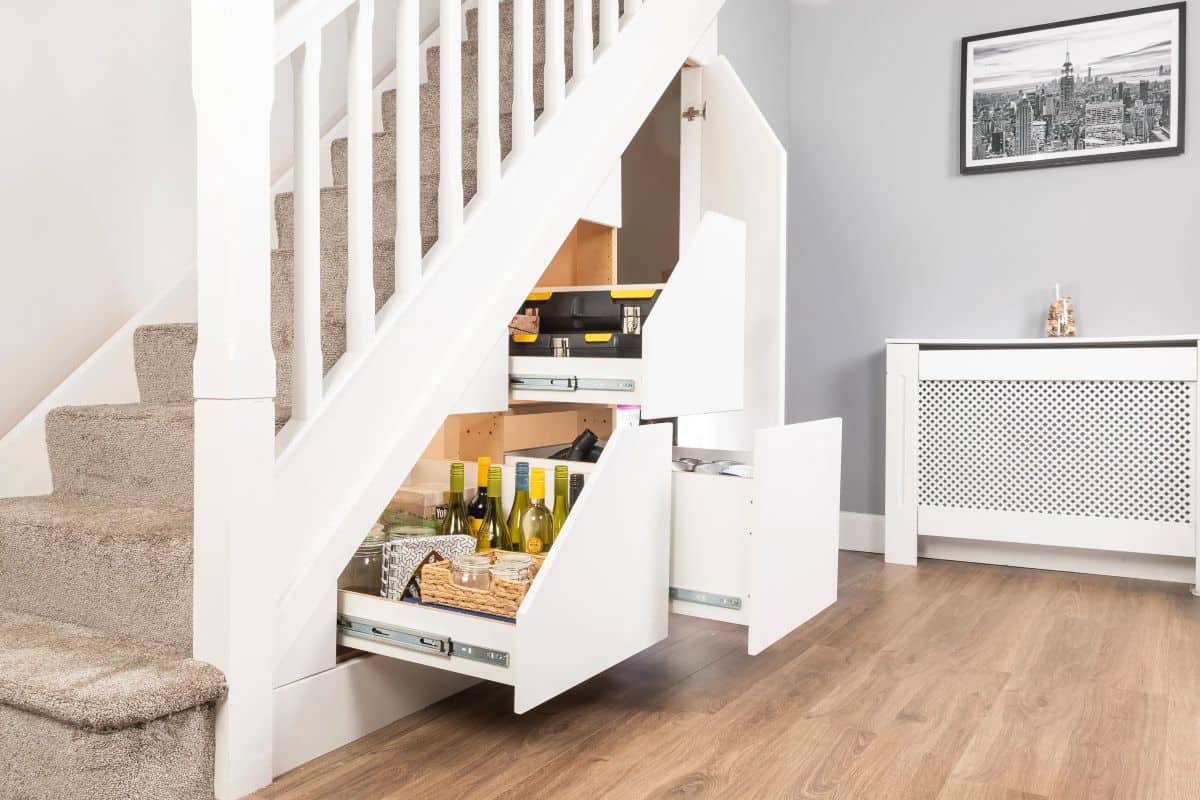- London Finest Interior Manufacturer

The space under the stairs often becomes a neglected nook in many homes. It’s either left empty, used to store shoes and coats, or filled with random clutter. But have you ever considered transforming it into a stylish and functional pantry? With some planning and imagination, this forgotten space can become a true gem in your home. Whether in a compact flat or a spacious house, an under stairs pantry can free up kitchen storage and bring clever design into your daily routine.
In this blog, we’ll explore a range of unique under stairs pantry storage ideas, tips on making them work for your space, and advice on ensuring they’re both practical and aesthetically pleasing.
Before we dive into the creative ideas, let’s address why you might want a pantry in this space in the first place:
Let’s explore some brilliant under stairs pantry storage ideas to inspire your makeover.
If the stairs are next to the kitchen or hallway, installing pull-out pantry drawers is a sleek solution. These drawers can be built into the stair frame or wall cavity, giving you deep, easy-access storage for everything from pasta and grains to tins and snacks. Use soft-close mechanisms for a luxurious touch.
An open-shelved pantry can turn functional storage into a design feature for homes with a modern or rustic aesthetic. Wooden or metal shelving can be snugly fitted into the under stairs alcove. Dry goods can be stored in matching glass jars, and baskets or crates can be kept for onions, potatoes, and other loose items.
Sometimes, you want your pantry tucked away and out of sight. Installing a sliding barn door or pocket door in front of your under stairs pantry keeps things concealed while still allowing easy access. This is especially effective if the area faces a main hallway or lounge and you want to maintain a clean visual flow.
Consider creating a mini walk-in pantry if your staircase allows for deeper space. With clever planning, you can fit in floor-to-ceiling shelving, hooks for bags, and even space for small appliances. It might feel like a luxury, but even modest staircases can accommodate a cosy walk-in feel if designed right.
If you’re working with a very narrow under stairs area, think vertical. Mount slim line shelving or pocket storage systems on the interior wall to hold spice jars, sauces, or packets. If you’re using a cabinet-style design, these can even be installed on the backs of doors.
For a seamless, built-in look, custom cabinetry is your best bet. Tailor the design with painted wood, shaker doors, or minimalist panels to match your kitchen’s finish. This approach gives you flexibility in layout—integrate a combination of cupboards, pull-outs, and drawers, each suited to different pantry essentials.
Why not take it a step further and integrate wine storage into your under stairs pantry? This works beautifully if you entertain often. Dedicate a few lower cubbies for bottles and keep nibbles, glasses, and drink accessories in nearby drawers.
If your home is country or farmhouse-style, bring that charm into your pantry. Use reclaimed wood shelves, vintage labels, and woven baskets. Add hooks for aprons or tea towels and perhaps even a chalkboard panel for your grocery list.
Not all under stairs pantries need to be rustic or traditional. A sleek, minimalist approach with handle less cabinets, uniform jars, and a monochrome palette can feel ultra-modern. If you prefer a discreet look, conceal the entire space with flush cabinetry.
If your kitchen lacks room for bulk shopping or large gadgets like the air fryer or slow cooker, your under stairs pantry can be an overflow zone. Fit in deep shelving or cubbies for stacking large packages and appliances. This keeps your main kitchen counters clear and helps streamline your cooking space.
Incorporate a chalkboard panel or pegboard inside your pantry for notes, shopping lists, or hanging utensils. A pegboard adds flexibility—rearrange hooks and small shelves as needed. It’s a functional addition that also adds a quirky, personal touch.
Before diving into the transformation, it’s essential to consider a few factors:
Transforming the space under your stairs into a well-organised pantry is more than just a storage hack—it’s a creative way to optimise your home’s layout while adding character and functionality. Whether you choose open shelving, bespoke cabinetry, or a hidden pantry behind sliding doors, there’s a solution to suit every home style and size.
With smart design choices, the under stairs area can become a delightful surprise—a pantry that’s practical, stylish, and a true conversation starter.
If you’re ready to rethink your storage strategy, the upstairs pantry might be the hidden gem your home has been waiting for. With creativity and thoughtful planning, even the smallest space can serve a big purpose.
Absolutely! Even the most compact staircases can accommodate a well-organised pantry. Use pull-out drawers, vertical shelving, and clever storage containers to maximise the space.
Costs can vary based on design. A DIY open-shelf pantry is relatively affordable, while custom cabinetry or sliding door systems will be pricier. However, the investment often pays off in added home value and daily convenience.
Yes, proper ventilation is essential to prevent musty smells and preserve food quality. Simple air vents or gaps in the cabinetry can make a big difference.
Avoid perishable items unless the space is temperature-controlled. Stick to dry goods, tinned food, snacks, and kitchen appliances that don’t need refrigeration.
Use LED strips, motion-sensor lights, or battery-operated puck lights. Good lighting ensures visibility and makes the pantry feel more inviting.
Weekly and Monthly Sales, Discounts & More!